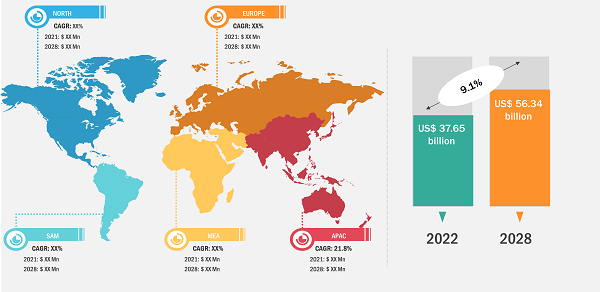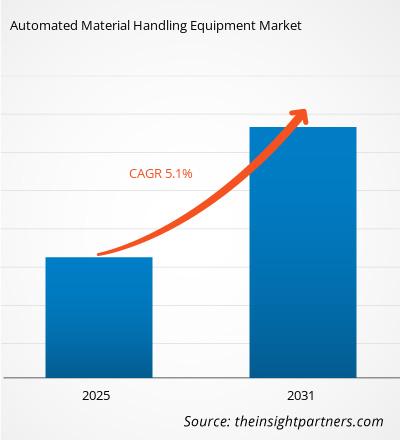自動マテリアルハンドリング機器の市場規模は、2022 年の 356 億 5,000 万米ドルから、 2031年までに563億4,000万米ドル。 2022 年から 2031 年までに 9.1% の CAGR を記録すると推定されています。
産業用ロボットは、人工知能 (AI)、ビッグデータ、その他のテクノロジーとますます絡み合っています。将来的には、ロボットが生産性を向上させ、人間に高度なスマート支援を提供すると予測されています。自動マテリアルハンドリングシステムは、人間の労働力の代わりにロボットを使用するコンピューター化された技術です。これらのシステムは、材料や製品を持ち上げたり、引っ張ったり、保管したり、押したり、取り出したりするために使用されます。自動マテリアルハンドリングシステムは、製造工場や倉庫などのさまざまな応用分野に新たな生産性をもたらします。産業用ロボットの時代の成長は、自動マテリアルハンドリング機器市場の成長。
プレーヤーAIと統合された産業用ロボットの開発に多額の投資を行っています。さらに、中国政府は産業用ロボットにAIを組み込む取り組みを拡大している。統合により人的介入が減り、労働力が不足し高価な国にとっては利益となるだろう。ただし、労働集約型経済では雇用の喪失につながる可能性もあります。
さらに、ロボット工学の導入が進み、ビッグデータが増加します。 、電子商取引への傾向の増加、マイクロフルフィルメントセンターの普及により、予測期間中に自動マテリアルハンドリング機器市場に有利なビジネスチャンスが創出されると予測されます。
戦略的洞察
自動マテリアルハンドリング機器市場の地域分析
地域的な観点から見ると、ヨーロッパは世界市場で 2 番目に大きな自動マテリアル ハンドリング機器市場シェアを保持している地域です。 自動車、エレクトロニクス、および半導体、電子商取引、金属および金属ヨーロッパ諸国の多くの産業では、自動マテリアルハンドリング (AMH) 装置の導入が進んでいます。ルーマニア、スロバキア、リトアニア、ポルトガル、エストニアを含む中欧および東欧の国々では、さまざまな業界で AMH 機器の導入が進んでいます。チェコ共和国とポーランドは最大の登山国であり、AMH機器の設置数はそれぞれ40%と25%増加した。自動車市場で確固たる存在感を示すドイツやイタリアなどの国では、AMH 装置の大幅な採用が注目されています。
以下に、地域の自動車組立および生産工場に関するいくつかの統計を示します。
- この地域には 301 の自動車組立およびエンジン生産工場があります。これらの植物のうち、194 は欧州連合内にあります。
- この地域の 134 の工場で乗用車を製造、52 の工場で大型車両 (トラック) を製造、41 の工場で小型商用車 (バン) を製造、72 の工場でエンジンを製造、66 18 社はバスを生産し、18 社はバッテリーを製造しています。
- ドイツ、フランス、イタリア、オランダ、ポーランド、スペインは、自動車の組立工場と生産工場を持つ主要国です。
したがって、巨大な自動車産業の存在が、ヨーロッパでの AMH 装置の設置を促進しています。
有利な地域 –自動マテリアルハンドリング機器市場
 市場洞察 –自動マテリアル ハンドリング装置市場
市場洞察 –自動マテリアル ハンドリング装置市場
システム タイプ- ベースの分析情報
システム タイプに基づいて、自動化されたマテリアルハンドリング機器市場は、ユニットロードとバルクロードに分かれています。 2022 年には、ユニットロードセグメントがより大きな市場シェアを保持しました。このシステムは、ユニットロード AMH システムの実用性に加えて構築の容易さにより、ほとんどの業界で好まれています。 ファクトリー オートメーションの成長に伴い、この種の材料の需要が増加しています。取り扱いシステムも増加する予定です。ユニット ロード AMH は通常、生産プロセスでのジャストインタイム配信とバッファ ストレージをサポートするために、進行中の作業操作時に導入されます。自動車、金属、自動車などの製造業重機、半導体、電子機器は、ユニットロード AMH システムの主要な消費者です。高密度パレット保管、特殊な積載、物品間の輸送技術、低温および低温輸送などのユニットロードの用途が拡大しています。冷凍庫保管、バッファリングおよびバッファリングステージングは、今後数年間、大きくて重い負荷を処理するためのユニット ロードの採用に耐えられると予想されます。ユニットロードの使用に関する前述の側面は、世界の自動マテリアルハンドリング機器市場に貢献するでしょう。
自動マテリアルハンドリング機器市場のプレーヤーは、主に高度で効率的な製品の開発に焦点を当てています。
- 2023 年 1 月、Trew, LLC (自動マテリアル ハンドリング ソリューション プロバイダー) は次のことを発表しました。オハイオ州南西部 (米国) にその拠点を拡大しています。同社は、マテリアルハンドリングソリューションの革新を加速するテクノロジーセンターを設立し、少なくとも 75 人の新規エンジニアリング職を創出することを目指しています。同社はジョブズオハイオ州からの研究開発補助金として最大400万米ドルの補助金を受け取ることになる。この助成金により、Trew は倉庫実行ソフトウェアと自動化テクノロジーを開発し、デモンストレーション、テスト、トレーニング施設を構築できるようになります。
- 2022 年 12 月、Ensign Equipment Inc. は、ドライバルク固体を処理するためのマテリアル ハンドリング機器および統合システムを設立しました。の組立工場の拡張が完了しました。この拡張により、Ensign Equipment Inc の組立スペースが 2 倍になり、自動マテリアル ハンドリング ソリューションに対する需要の高まりに対応します。
自動マテリアルハンドリング機器の市場規模は、北米、ヨーロッパ、アジア太平洋 (APAC)、中東、および地域の 5 つの主要地域に分割されています。アフリカ、そして南アメリカ。 2022 年には、APAC が大幅な収益シェアで自動マテリアルハンドリング機器市場をリードし、ヨーロッパがそれに続きました。さらに、アジア太平洋地域は、2022 年から 2031 年にかけて自動マテリアルハンドリング機器市場で最高の CAGR を記録すると予想されています。
株式会社ダイフク;ハイスターエールマテリアルハンドリング株式会社;ユングハインリッヒAG;キオングループAG;株式会社豊田自動織機;ハンファ株式会社;ジョン・ビーン・テクノロジーズ・コーポレーション;クカAG;ボイマー グループ GmbH &株式会社; Fives Group は、業界で活動する自動マテリアルハンドリング機器市場の主要プレーヤーの 1 つです。市場レポートは、主要企業が今後数年間の成長戦略を立てるのに役立つ詳細な市場洞察を提供します。
- 過去2年間の分析、基準年、CAGRによる予測(7年間)
- PEST分析とSWOT分析
- 市場規模価値/数量 - 世界、地域、国
- 業界と競争環境
- Excel データセット



Report Coverage
Revenue forecast, Company Analysis, Industry landscape, Growth factors, and Trends

Segment Covered
This text is related
to segments covered.

Regional Scope
North America, Europe, Asia Pacific, Middle East & Africa, South & Central America

Country Scope
This text is related
to country scope.
よくある質問
Some of the customization options available based on request are additional 3–5 company profiles and country-specific analysis of 3–5 countries of your choice. Customizations are to be requested/discussed before making final order confirmation, as our team would review the same and check the feasibility.
The Automated Material Handling Equipment Market is expected to register a CAGR of 5.1% from 2023-2031.
The major factors impacting the Automated Material Handling Equipment Market are: Increasing Demand for Automation in Warehousing, Rising Adoption in E-commerce and Retail, and Technological Advancements in Robotics and AI
Key future trends in this market are - Growth in e-commerce logistics, Adoption of robotics in warehouses, Demand for operational efficiency
The report can be delivered in PDF/PPT format; we can also share excel dataset based on the request.
Key companies in this market are: Fives, Jungheinrich AG, Kion Group AG, kuka AG, Daifuku Co Ltd, Hyster Yale Materials Handling Inc, BEUMER Group GmbH Co KG, Hanwha Corporation, John Bean Technologies Corporation
Trends and growth analysis reports related to Electronics and Semiconductor : READ MORE..
The List of Companies
1. Fives
2. Jungheinrich AG
3. Kion Group AG
4. kuka AG
5. Daifuku Co., Ltd.
6. Hyster-Yale Materials Handling, Inc.
7. BEUMER Group GmbH & Co. KG
8. Hanwha Corporation
9. John Bean Technologies Corporation
10. Toyota Industries Corporation
The Insight Partners performs research in 4 major stages: Data Collection & Secondary Research, Primary Research, Data Analysis and Data Triangulation & Final Review.
- Data Collection and Secondary Research:
As a market research and consulting firm operating from a decade, we have published and advised several client across the globe. First step for any study will start with an assessment of currently available data and insights from existing reports. Further, historical and current market information is collected from Investor Presentations, Annual Reports, SEC Filings, etc., and other information related to company’s performance and market positioning are gathered from Paid Databases (Factiva, Hoovers, and Reuters) and various other publications available in public domain.
Several associations trade associates, technical forums, institutes, societies and organization are accessed to gain technical as well as market related insights through their publications such as research papers, blogs and press releases related to the studies are referred to get cues about the market. Further, white papers, journals, magazines, and other news articles published in last 3 years are scrutinized and analyzed to understand the current market trends.
- Primary Research:
The primarily interview analysis comprise of data obtained from industry participants interview and answers to survey questions gathered by in-house primary team.
For primary research, interviews are conducted with industry experts/CEOs/Marketing Managers/VPs/Subject Matter Experts from both demand and supply side to get a 360-degree view of the market. The primary team conducts several interviews based on the complexity of the markets to understand the various market trends and dynamics which makes research more credible and precise.
A typical research interview fulfils the following functions:
- Provides first-hand information on the market size, market trends, growth trends, competitive landscape, and outlook
- Validates and strengthens in-house secondary research findings
- Develops the analysis team’s expertise and market understanding
Primary research involves email interactions and telephone interviews for each market, category, segment, and sub-segment across geographies. The participants who typically take part in such a process include, but are not limited to:
- Industry participants: VPs, business development managers, market intelligence managers and national sales managers
- Outside experts: Valuation experts, research analysts and key opinion leaders specializing in the electronics and semiconductor industry.
Below is the breakup of our primary respondents by company, designation, and region:

Once we receive the confirmation from primary research sources or primary respondents, we finalize the base year market estimation and forecast the data as per the macroeconomic and microeconomic factors assessed during data collection.
- Data Analysis:
Once data is validated through both secondary as well as primary respondents, we finalize the market estimations by hypothesis formulation and factor analysis at regional and country level.
- Macro-Economic Factor Analysis:
We analyse macroeconomic indicators such the gross domestic product (GDP), increase in the demand for goods and services across industries, technological advancement, regional economic growth, governmental policies, the influence of COVID-19, PEST analysis, and other aspects. This analysis aids in setting benchmarks for various nations/regions and approximating market splits. Additionally, the general trend of the aforementioned components aid in determining the market's development possibilities.
- Country Level Data:
Various factors that are especially aligned to the country are taken into account to determine the market size for a certain area and country, including the presence of vendors, such as headquarters and offices, the country's GDP, demand patterns, and industry growth. To comprehend the market dynamics for the nation, a number of growth variables, inhibitors, application areas, and current market trends are researched. The aforementioned elements aid in determining the country's overall market's growth potential.
- Company Profile:
The “Table of Contents” is formulated by listing and analyzing more than 25 - 30 companies operating in the market ecosystem across geographies. However, we profile only 10 companies as a standard practice in our syndicate reports. These 10 companies comprise leading, emerging, and regional players. Nonetheless, our analysis is not restricted to the 10 listed companies, we also analyze other companies present in the market to develop a holistic view and understand the prevailing trends. The “Company Profiles” section in the report covers key facts, business description, products & services, financial information, SWOT analysis, and key developments. The financial information presented is extracted from the annual reports and official documents of the publicly listed companies. Upon collecting the information for the sections of respective companies, we verify them via various primary sources and then compile the data in respective company profiles. The company level information helps us in deriving the base number as well as in forecasting the market size.
- Developing Base Number:
Aggregation of sales statistics (2020-2022) and macro-economic factor, and other secondary and primary research insights are utilized to arrive at base number and related market shares for 2022. The data gaps are identified in this step and relevant market data is analyzed, collected from paid primary interviews or databases. On finalizing the base year market size, forecasts are developed on the basis of macro-economic, industry and market growth factors and company level analysis.
- Data Triangulation and Final Review:
The market findings and base year market size calculations are validated from supply as well as demand side. Demand side validations are based on macro-economic factor analysis and benchmarks for respective regions and countries. In case of supply side validations, revenues of major companies are estimated (in case not available) based on industry benchmark, approximate number of employees, product portfolio, and primary interviews revenues are gathered. Further revenue from target product/service segment is assessed to avoid overshooting of market statistics. In case of heavy deviations between supply and demand side values, all thes steps are repeated to achieve synchronization.
We follow an iterative model, wherein we share our research findings with Subject Matter Experts (SME’s) and Key Opinion Leaders (KOLs) until consensus view of the market is not formulated – this model negates any drastic deviation in the opinions of experts. Only validated and universally acceptable research findings are quoted in our reports.
We have important check points that we use to validate our research findings – which we call – data triangulation, where we validate the information, we generate from secondary sources with primary interviews and then we re-validate with our internal data bases and Subject matter experts. This comprehensive model enables us to deliver high quality, reliable data in shortest possible time.

 このレポートの無料サンプルを入手する
このレポートの無料サンプルを入手する